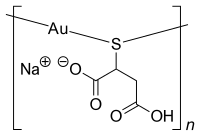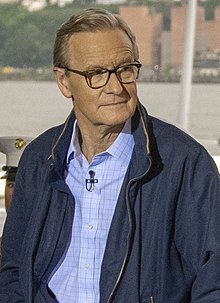오로티오말레이트 나트륨
Sodium aurothiomalate | |
| 임상자료 | |
|---|---|
| 상명 | 묘크리신 |
| AHFS/Drugs.com | 멀티um 소비자 정보 |
| 라이센스 데이터 | |
| 임신 , 카테고리 |
|
| 경로: 행정 | 근육내 |
| ATC 코드 |
|
| 법적현황 | |
| 법적현황 | |
| 약동학 데이터 | |
| 단백질 결합 | 높은[1] |
| 제거 반감기 | 6-25일[1] |
| 배설 | 소변(60~90%), 조류(10~40%)[1] |
| 식별자 | |
| |
| CAS 번호 | |
| 펍켐 CID | |
| 켐스파이더 | |
| 유니 | |
| 체비 | |
| CompTox 대시보드 (EPA) | |
| ECHA InfoCard | 100.032.242 |
| 화학 및 물리적 데이터 | |
| 공식 | C4H4Au나O4S |
| 어금질량 | 367.939350590 g·190−1 |
| 3D 모델(JSmol) | |
| |
| |
| (iii) | |
아로티오말산나트륨(INN, 미국에서 금나트륨 티오말산염으로 알려져 있음)은 면역억제적 항류혈성 효과에 사용되는 금화합물이다.[2][3] 경구 투여 금염인 오라노핀과 함께 현재 현대 의학에서 사용되는 두 가지 금 화합물 중 하나이다.[4]
의학적 용법
결핵 치료에도 효과가 있는 것으로 입증됐지만 주로 중증의 류마티스 관절염에 대해 근육내 주사로 매주 1~2회 투여한다.[5]
역효과
그것의 가장 흔한 부작용은 나투의 소화기(대부분의 소화불량, 입덧, 메스꺼움, 구토, 미각장애), 바소모터(대부분 홍조, 실신, 현기증, 땀, 허약, 두근거림, 호흡곤란, 흐릿한 시야) 또는 피부과(대개 주사부위 근처의 국소 자극, 탈모)이다.다시, 비록 결막염, 혈액 이상, 신장 손상, 관절 통증, 근육통/통증, 간 기능 장애도 흔하지만.[6] 덜 흔하게, 그것은 GI 출혈, 마른 점막, 그리고 치염의 원인이 될 수 있다.[6] 드물게, 재생불량성 빈혈, 궤양성 장염, 삼키기 어려움, 혈관부종, 폐렴, 폐섬유화, 간독성, 간독성, 황달성, 말초신경병증, 길레인-바레증후군, 뇌병증, 뇌염, 뇌염, 그리고 광감성을 일으킬 수 있다.[6]
약리학
정확한 작용기전은 알려지지 않았지만 프로스타글란딘의 합성을 억제한다고 알려져 있다.[4] 또한 혈소판 세포를 변조하고 등급 II의 주요 조직적합성 복합-펩타이드 상호작용을 억제한다.[4] 또한 다음과 같은 효소를 억제하는 것으로 알려져 있다.[4][7]
사용내역
이 화합물의 우호적인 사용에 대한 보고는 1929년 자크 포레스티에에 의해 프랑스에서 발표되었다.[9] 당시 금염의 사용은 논란의 여지가 있는 치료법이었으며 국제사회에서 즉각 받아들여지지 않았다. 1940년 금염의 사용에 의한 라울 뒤피의 관절통 치료에서 성공이 발견되었다; (치료로) 몇 주 동안 이렇게 눈부신 치유의식을 가져왔고, 뒤피는 이동 중에 전차를 탈 수 있는 능력을 다시 자랑했다."[10]
최근 오로티오글루코스와 함께 미국 시장에서 단종돼 오라노핀만 미국 시장에 유일한 금염으로 남겼다.
참조
- ^ a b c "aurothiomalate, sodium, Myochrysine (gold sodium thiomalate) dosing, indications, interactions, adverse effects, and more". Medscape Reference. WebMD. Retrieved 13 March 2014.
- ^ Jessop JD, O'Sullivan MM, Lewis PA, Williams LA, Camilleri JP, Plant MJ, Coles EC (September 1998). "A long-term five-year randomized controlled trial of hydroxychloroquine, sodium aurothiomalate, auranofin and penicillamine in the treatment of patients with rheumatoid arthritis". British Journal of Rheumatology. 37 (9): 992–1002. doi:10.1093/rheumatology/37.9.992. PMID 9783766.
- ^ Iqbal MS, Saeed M, Taqi SG (2008). "Erythrocyte membrane gold levels after treatment with auranofin and sodium aurothiomalate". Biological Trace Element Research. 126 (1–3): 56–64. doi:10.1007/s12011-008-8184-x. PMID 18649049. S2CID 20169992.
- ^ a b c d Kean WF, Kean IR (June 2008). "Clinical pharmacology of gold". Inflammopharmacology. 16 (3): 112–25. doi:10.1007/s10787-007-0021-x. PMID 18523733. S2CID 808858.
- ^ Benedek TG (January 2004). "The history of gold therapy for tuberculosis". Journal of the History of Medicine and Allied Sciences. 59 (1): 50–89. doi:10.1093/jhmas/jrg042. PMID 15011812. S2CID 37436710.
- ^ a b c Rossi S, ed. (2013). Australian Medicines Handbook (2013 ed.). Adelaide: The Australian Medicines Handbook Unit Trust. ISBN 978-0-9805790-9-3.
- ^ Berners-Price SJ, Filipovska A (September 2011). "Gold compounds as therapeutic agents for human diseases". Metallomics. 3 (9): 863–73. doi:10.1039/c1mt00062d. PMID 21755088.
- ^ Tuure L, Hämäläinen M, Moilanen T, Moilanen E (2014). "Aurothiomalate inhibits the expression of mPGES-1 in primary human chondrocytes". Scandinavian Journal of Rheumatology. 44 (1): 74–9. doi:10.3109/03009742.2014.927917. PMID 25314295. S2CID 5213201.
- ^ Freyberg RH, Block WD, Levey S (July 1941). "Metabolism, Toxicity and Manner of Action of Gold Compounds Used in the Treatment of Arthritis. I. Human Plasma and Synovial Fluid Concentration and Urinary Excretion of Gold During and Following Treatment With Gold Sodium Thiomalate, Gold Sodium Thiosulfate, and Colloidal Gold Sulfide". The Journal of Clinical Investigation. 20 (4): 401–12. doi:10.1172/jci101235. PMC 435072. PMID 16694848.
- ^ Lamboley C (December 6, 2010). "Deux rhumatisants au soleil du Midi : Renoir et Dufy" [Two rheumatic in the Midi sun: Renoir and Dufy] (PDF). Académie des Sciences et Lettres de Montpellier (in French). Montpellier. Retrieved July 7, 2015.


